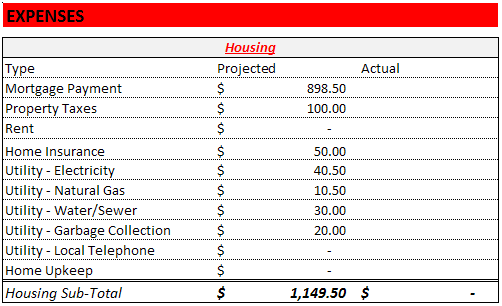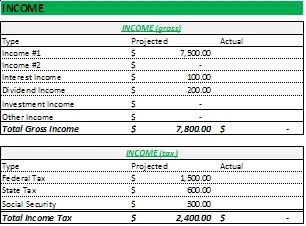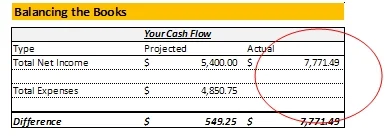Budget Guide - Completing a Personal Budget Worksheet

Get rid of your debt faster with debt relief
Choose your debt amount
Or speak to a debt consultant 844-731-0836
- 4 min read
Steps to Completing Your Personal Budget Worksheet
| Bills.com Budget Guide |
|---|
| The Need for a Budget |
| Creating a Personal Budget |
| Your Budget Worksheet |
| Analyze Your Cash Flow |
| Eliminating Unhealthy Debts |
| Setting Long Term Goals |
| On the Road to Financial Freedom |
Follow the 7 steps below to complete your own Bills.com personal budget worksheet:
Download the Bills.com Budget Worksheets
1. Fill in the area on the worksheet for projected expenses:
Don’t worry about complete accuracy. The purpose of filling in the projected numbers is to compare them later on with your actual expenses. Your projected numbers will serve as a basis for you to gauge your knowledge of your own cash flow.
The further off you are on your estimates, the more important that it is for you to keep a budget.
Also, your projected income and expenses will illustrate whether you think you are earning enough to cover your monthly expenses or need to rely on running up debt to cover your cash outflows.
Example:

2. Fill in the area on the worksheet for projected income and taxes:
Your next step is to fill in projected gross (pre-tax) income amounts. Your sources of income include your primary job, a second job, any interest or investment income, and any alimony and child support.
Income can vary from month to month, for positive or negative reasons, such as reduced hours, overtime pay, bonuses, commissions or for seasonal work. Do your best to estimate the average monthly income.
After your income, estimate all of the taxes that are deducted from your paycheck. Include your state and federal income taxes as well as your social security obligations. Include the taxes on any other sources of income such as interest or dividends. Estimate these taxes on a monthly basis.
Example:

3. Calculate Your Projected Cash Flow:
- Total your projected expenses Calculate your total expenses by adding all the sub-total amounts of each expense category.
- Total your projected net income Calculate your total net income by subtracting your total taxes from your gross income total.
- Balance your budget Subtract your total expenses from your total net income. Do you have a surplus or a deficit?
Example:

4. Gather all the receipts and records of your expenses:
As you collect all of your bills and receipts, there may be bills you just cannot locate. That's OK.
Start keeping all your records in an organized manner. You can do it the old-fashioned way, by keeping copies of all your bills in manila envelopes or you can use an online product like Mint or many other free online budgeting systems. Have an envelope for each main expense category and develop a habit of putting all the receipts in the envelopes at the end of the day.
Even when you use an online tool, which requires you to link your bank and credit accounts to the online system, not all of your expenses will appear. Cash purchases need to be manually entered into the online system, so you need to keep the receipts in good order whether you use an online system or not.
5. Fill in Your Actual Monthly Expenses:
Once you gather all your bills, receipts, and bank records, you can start filling in your worksheet. If you can’t come up with the exact amount for an expense, estimate what you spent as best you can.
Pay particular attention to expense items that are listed on your worksheet that you pay annually or periodically. Because you do not spend money on them each month, it can be easy to leave them out.
To calculate annual expenses, take the annual expense for an item and convert it into a monthly amount. For example, if your car insurance is paid once a year and costs you $900, divide by 12 to calculate the monthly amount, which would be $75. Also, look carefully at expenses that vary on a seasonal basis, such as your utility bills.
If you know that the dollar amount listed for the most recent month is not representative of what you normally spend, use your best estimate for your average monthly expense and track that category carefully.
Example:

6. Figure Your Income and Your Tax Obligations:
- Gather all records of your income and taxes Collect your recent pay-stubs. You want to use pay-stubs for a one-month period that best represents your normal income. Include all sources of income.
- Fill in your actual monthly income and taxes Enter your actual gross income and tax deductions on the spreadsheet. Your taxes should be clearly itemized on your paystub.
Example:
7. Calculate Your Actual Cash Flow:
- Total your actual expenses Calculate your total expenses by adding all the sub-total amounts of each expense category.
- Total your actual income Calculate your total net income by subtracting your total taxes from your gross income total.
- Balance your budget Subtract your total expenses from your total net income. Do you have a surplus or a deficit?
Example:

Back:Creating a Personal Budget Next: Analyze Your Cash Flow
Download the Bills.com Personal Budget Guide
Get the full printable Bills.com budget guide!

Get rid of your debt faster with debt relief
Take the first step towards a debt-free life with personalized debt reduction strategies.
Choose your debt amount
Or speak to a debt consultant 844-731-0836
How do I unprotect the worksheet so I can customize???
The sheet is protected in order to ensure that the user does not erase the formulas. So, at this point, it is not customizable.
We also have a budget tool that allows you to save your results.